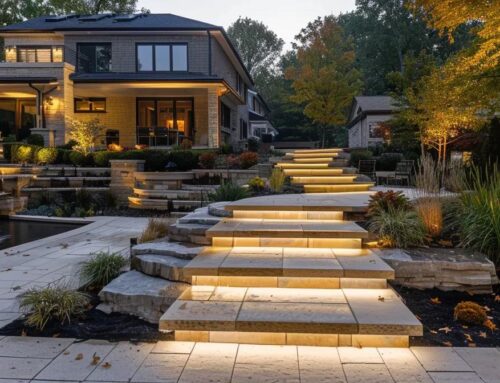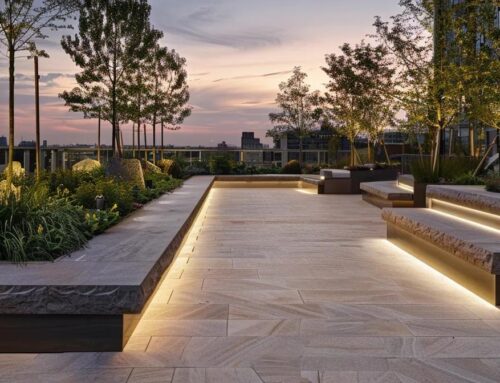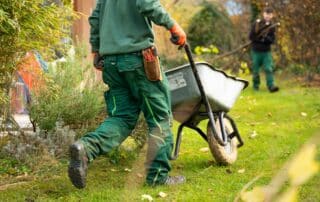A well-designed outdoor space isn’t just about plants or patios—it’s about how those elements interact to support the natural environment, improve accessibility, and enhance property value. Homeowners often wonder whether they should prioritize hardscape features like walkways and retaining walls or invest in softscape elements such as soil, trees, and shrub arrangements. The truth is, understanding the roles of both hardscaping and landscaping is key to building a beautiful, functional, and sustainable yard that performs well in any climate.
This blog breaks down the differences between hardscaping and landscaping and explores how each contributes to ecosystem services, drainage, curb appeal, and long-term maintenance. We’ll explore practical guidance on integrating softscape and hardscape elements to create an outdoor space that supports soil health, air quality, and biodiversity—while also offering the permanence of durable architecture and functional surfaces like patios and driveways.
What Is the Difference Between Hardscaping and Landscaping?
Hardscaping refers to the built environment—features like patios, concrete walkways, retaining walls, fireplaces, and driveways. These structures form the architectural skeleton of your yard and offer essential benefits like drainage control, space optimization, and durability against wind, flood, and other natural forces.
Landscaping, or more precisely softscaping, involves living elements such as grass, trees, mulch, soil, flowers, and shrubs. These organic materials support ecological balance by filtering pollutants, enriching the soil with organic matter and nitrogen, and improving the yard’s canopy cover. Softscape designs often enhance biodiversity, regulate microclimates, and create visually appealing depth of field and texture—akin to the principles seen in professional landscape photography.
Together, these two disciplines complement one another, balancing the structural permanence of hardscape with the seasonal beauty and life of natural ecosystems.
When Should You Prioritize Hardscaping?

If your property experiences drainage issues, poor soil stability, or lacks defined outdoor living zones, hardscaping should take the lead. A well-planned retaining wall, for instance, prevents soil erosion and helps manage stormwater flow. Driveways and walkways built with concrete, stone, or wood can improve accessibility and prevent damage caused by seasonal floods or rapid climate shifts.
Homeowners also choose hardscaping to expand usable space. A patio with a fire pit or outdoor fireplace becomes an entertainment zone. Raised walls define areas for tree planting or fountain installations, enhancing both usability and curb appeal. Professionally designed hardscape elements also reduce maintenance—eliminating the need for excessive weed control or pest management in certain zones.
How Does Landscaping Contribute to Long-Term Property Health?

Landscaping does more than make your yard look beautiful—it sustains the ecosystem that surrounds your home. Layers of mulch and bark regulate soil temperature, retain moisture, and minimize weed control needs. Trees and shrubs improve air quality by reducing airborne pollutants and sequestering carbon. In fact, urban forest research shows that areas with dense plant cover support stronger wildlife habitats and deliver better ecosystem services such as flood absorption and climate resilience.
Features like irrigation systems, sod, and targeted fertilizer use also improve lawn performance and nutrient cycling. With the right care—either through DIY efforts or professional lawn care services—your lawn and garden become part of a healthier, more sustainable outdoor environment.
Can Hardscaping and Landscaping Be Combined Effectively?
Absolutely—and the most impressive outdoor spaces rely on this very integration. Imagine a walkway bordered by layered shrub beds and accented with low landscape lighting, or a fire pit encircled by flowering trees and perennials planted for pollinator support. These combinations increase the beauty, usability, and sustainability of your yard.
From a civil engineering perspective, combining the structural benefits of hardscaping with the ecological depth of landscaping offers the best return. Even details like using permeable pavers can reduce runoff while still providing the architectural strength of traditional hardscape materials. These hybrid designs are not only visually rich, they also meet growing demands for environmentally friendly outdoor living.
What Are the Maintenance and Cost Considerations?
Hardscape features generally require less frequent upkeep. Sealing a patio or repairing a cracked walkway is far less involved than dealing with pest control, lawn disease, or nutrient depletion in soil-based zones. However, upfront costs are usually higher for hardscaping due to materials like concrete, stone, and installation labor.
Landscaping, on the other hand, is more dynamic. It requires seasonal care—pruning, fertilizing, weeding, and re-mulching—but often costs less to implement initially. The good news? Many services now offer hybrid landscape maintenance plans that balance both needs, ensuring your outdoor space remains functional and attractive throughout the year.
Final Thoughts
The conversation between hardscaping and landscaping isn’t a competition—it’s a collaboration. A well-structured backyard draws on both: hardscape features create zones of function and flow, while landscaping adds color, texture, and life. Together, they elevate your outdoor environment’s architecture, support the local ecosystem, and offer lasting improvements in value, accessibility, and beauty.
Whether you’re redesigning a yard from scratch or refining a small section, blending softscape and hardscape with intention ensures your space not only looks remarkable but also performs efficiently, resists environmental stress, and delivers real everyday joy.




